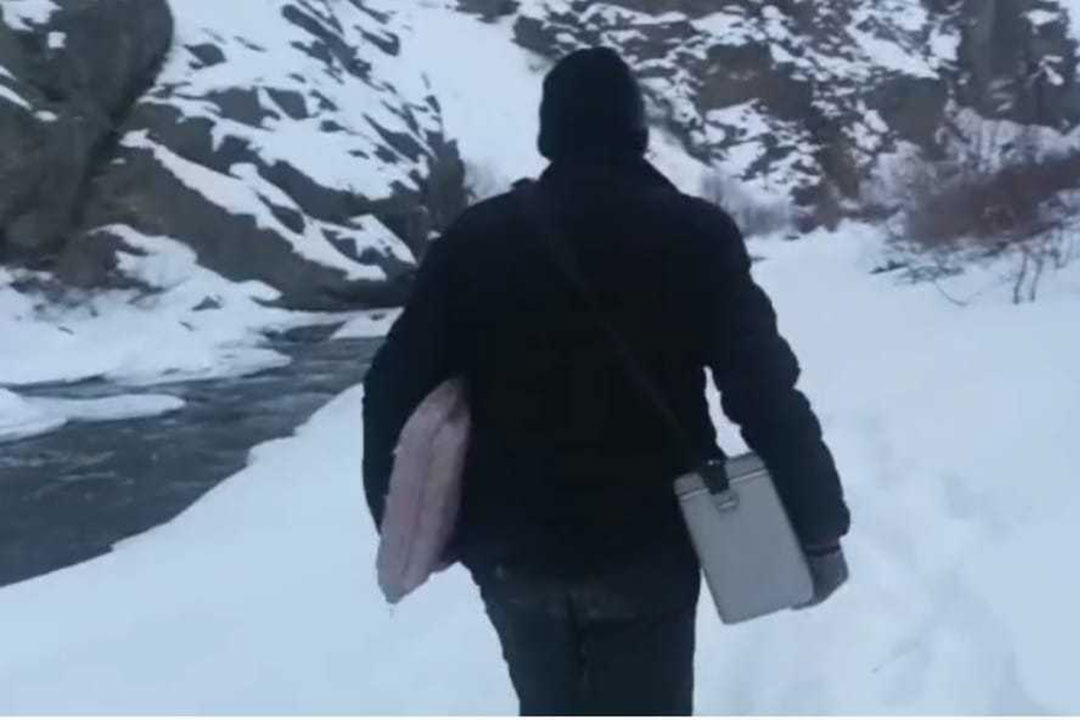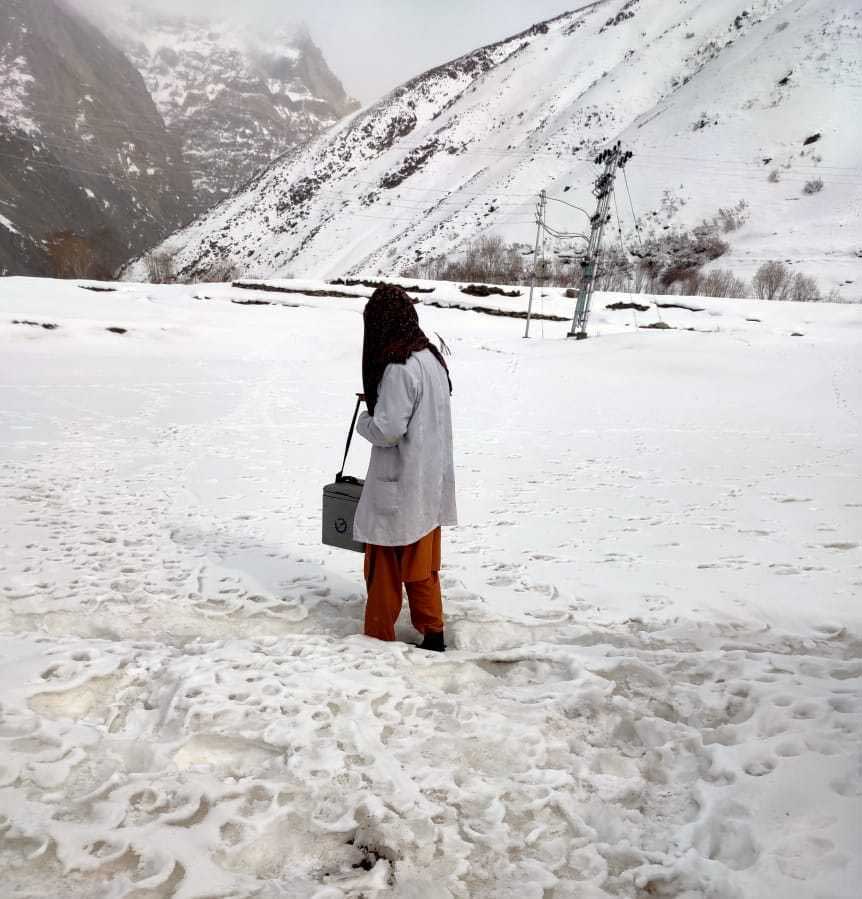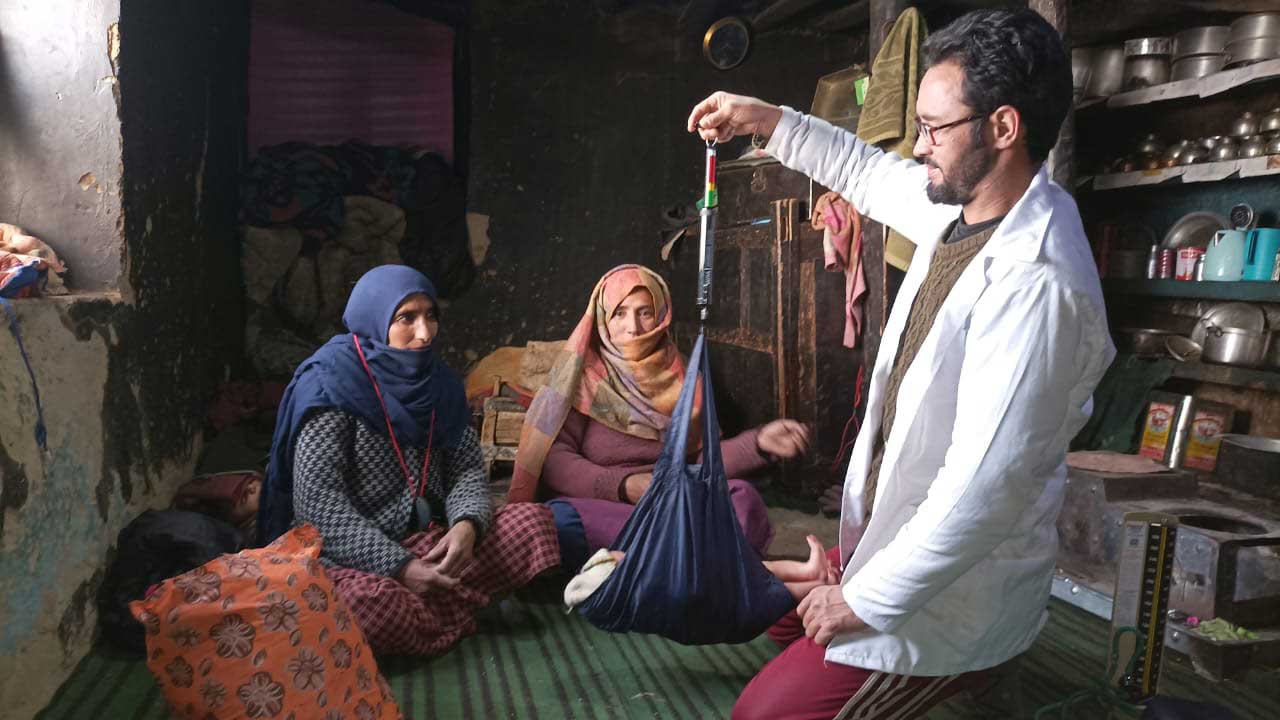Himalayan vaccinators brave the elements to ensure every last family in a remote Indian village is reached
Frostnip and chills, ice, snow, and shooting stones are just some of the hurdles facing vaccinators on the path to high-altitude Itchoo, population 159.
- 4 April 2023
- 5 min read
- by Nasir Yousufi

With a box of vaccine vials and other medicines slung over their shoulders, health workers in Sankoo subdivision, part of Kargil district in Himalayan Ladakh, brave the tough terrain, sub-zero temperatures and long hours of exertion to vaccinate the region's furthest human habitations.
As the darkness gradually fades away, giving a way to the bright light of dawn, the two young vaccinators wait anxiously. For the past 15 minutes, Fatima, 26, and Suleman, 32, have been trying to call the local man who usually accompanies them for the gruelling three-hour journey to a nearby mountainous village. It's no use – he doesn't pick up. They have wasted too much valuable time already, and decide to set off alone.
"During this winter alone, I caught cold and fever almost three times after the long snow walks."
– Suleman, health worker from Sankoo subdivision
More waiting would mean more risk ahead during their journey to the high-altitude village of Itchoo, which, according to the 2011 census, has a population of just 159. In winters, Itchoo is all but cut off, but vaccinators like Fatima and Suleman walk over ice and snow for hours to ensure that every last house receives vaccines and medical aid.

Credit: Block Medical Office, Sankoo
During the morning hours, when the sunshine is feeble, walking on ice and snow is comparatively easier than during the warmer hours of the day, when bright sun can trigger avalanches or landslides as the ice packing the ground starts to melt and shift.
"We prefer to walk the tedious path during the wee hours of the morning. In later parts of the day, it is very risky. Recently, I was almost hit by shooting stones on the way to Itchoo," Fatima told VaccinesWork, referring to rocks that can spit off of steep, unstable slopes at high speeds, commonly imperiling traffic on Himalayan roads.
"We are highly grateful to the health workers. Be it a vaccine, a medicine or emergency medical aid, they are always there. During COVID-19, our entire population was vaccinated."
– Mohammad Haider, Itchoo village head
Fatima and Suleman make the journey to Itchoo – 8km on foot from their base centre at Shergandi village, across ice, and snow, and the frozen streams nestling between two high mountains – every fortnight. High up and 85km away from Kargil district headquarters, Itchoo lacks any road connectivity.
Have you read?
Other villages in the region are better connected, but not by much. Shergandi is on a road that also passes through Sankoo town, but only a single bus runs on this 35km hill route, and that only on alternate days.
Apart from the risky hikes their work demands, the health workers also brave harsh climatic conditions to keep their communities healthy.
"In order to carry out routine vaccination and provide medical help to the local population, we need to make frequent visits to [Itchoo]," Suleman explained. "After doing routine vaccination and health check-ups, we usually stay back in the village for days together, as the same day return after huge exertion is quite impossible. But during winters it is really hard to stay in such a freezing conditions.
"You have to melt ice to get water. During this winter alone, I caught cold and fever almost three times after the long snow walks," he added.
"Every time my feet are exposed to snow for longer hours, they develop snow bites. Despite wearing boots and a three layer of socks I get the bites," Fatima said, referring to a condition also called frostnip. But it's more than a sense of duty that drives her to provide all of these services despite the risk and exertion. She does it, she said, for the satisfaction of her inner soul. "As I see the smile on the faces of locals, it gives me an inner solace," she explained.
Most people in Itchoo are pastoralists earning their livelihoods from rearing herds of cattle and sheep. Agriculture is sparse in the area. People rely on external sources for food and vegetables. "Whenever we go into the village, we take vegetables and other food items from Sankoo as it is pretty hard to get anything here," Fatima explained.
"At times it is very hard to access the remote villages in the mountains, given their tough topography, but the department ensures that vaccine and medical aid reaches up to last family."
– Munawar Hussain, Chief Medical Officer, Kargil
"We are highly grateful to the health workers. The department has been greatly helpful to us for all these years. Be it a vaccine, a medicine or emergency medical aid, they are always there. During COVID-19, our entire population was vaccinated," said Mohammad Haider, Itchoo village head.
Ali Hashmi, the manager of Subdivision Hospital Sankoo, said that in addition to vaccination and medical aid, health workers in the remote areas like Itchoo and Shergandi do a tremendous job in facilitating the shifting of serious patients to Sankoo and Kargil hospitals for more advanced treatment. Mostly these patients are carried on stretchers shouldered by locals for long distances until they find a motorable road.

Credit: Nasir Yousufi
"At times it is very hard to access the remote villages in the mountains, given their tough topography, but the department ensures that vaccine and medical aid reaches up to last family. In areas that are fairly populated, we have already community health centres in place, while as in remote villages like Shergandi, we have health and wellness centres," said Munawar Hussain, Chief Medical Officer, Kargil. "Moreover, our teams make regular visits to sparsely populated habitations located high up in the mountains to provide the necessary medical aid and the routine vaccines."
According to the data available with Block Medical Officer Sankoo, Dr Ghulam Hussain, the area witnessed nearly 100 percent vaccination during both first and second phases of the COVID-19 vaccination drive. Nearly 60% of the eligible population have taken the booster doses too, the official said. On average, every month the department carries out about 1,000 routine vaccinations despite the harsher climatic conditions and tough terrain, he added.









